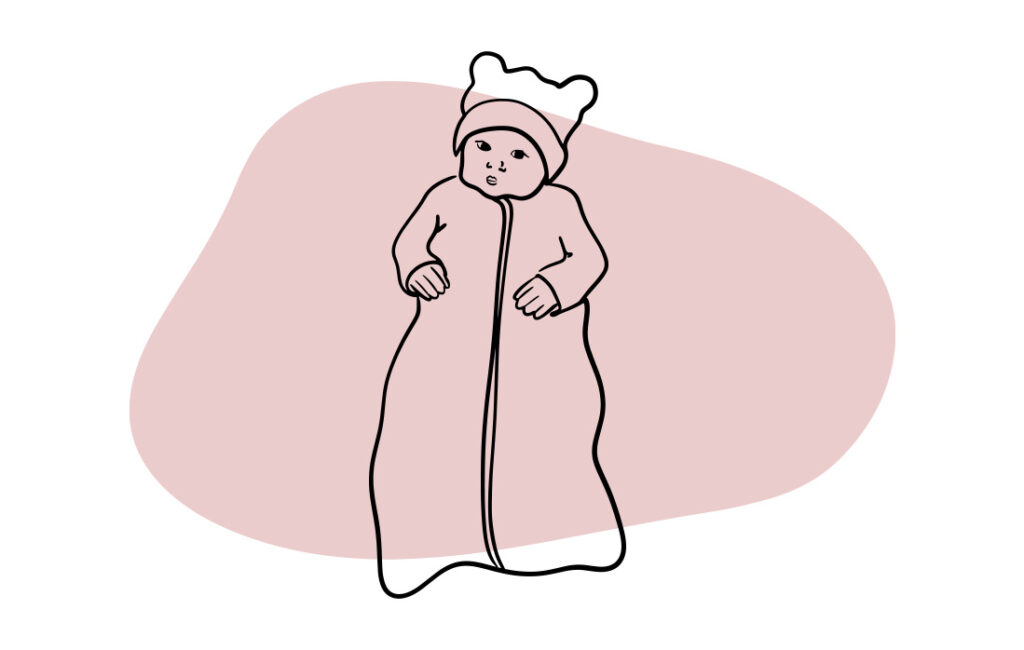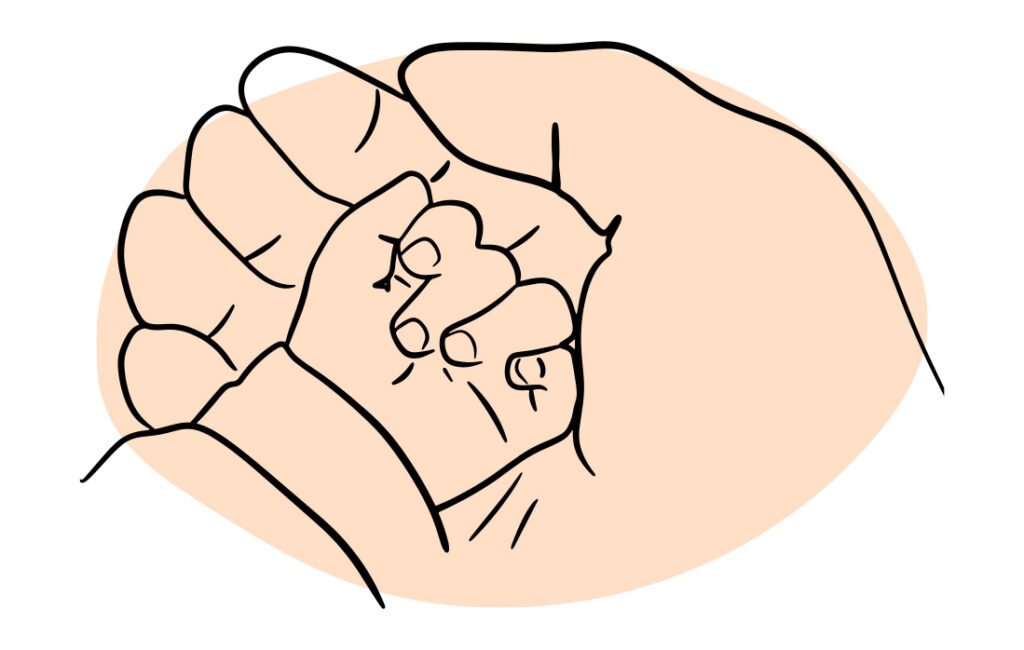Weighted Sleep Sacks: A Pediatrician Weighs In On This Controversial Sleepwear
Disclosure: By clicking on the product links in this article, Mattress Nerd may receive a commission fee at no cost to you, the reader. Read full disclosure statement.
Medically reviewed by Dr. Pierrette Mimi Poinsett, MD, pediatrician, and consultant for Mom Loves Best.
Weighted sleep sacks are a type of cute but controversial sleepwear that claims to use added weight to help soothe your baby to sleep. But do they actually work? And could they cause more harm than good?
We spoke with a pediatrician to find out whether weighted sleep sacks are safe or effective. In this article, we’re weighing the potential benefits and risks of this sleep accessory.

What is a Weighted Sleep Sack?
A sleep sack is a product that’s designed to keep babies warm at bedtime without adding any loose bedding. They look like wearable sleeping bags with shoulder straps and a zipper.
Weighted sleep sacks feature beads inside the product’s fabric to make them heavier than regular fabric. These are typically used as an alternative to swaddling once a baby gets active enough to undo the wrap during the night.
Why are Weighted Sleep Sacks so Popular?
While swaddling your baby helps restrict movement, a sleep sack will allow them to move more freely. They can kick their legs and move their arms while in a sleep sack, so this option works for babies that have outgrown a swaddle.
Some parents rave about how weighted sleep sacks help their babies fall and stay asleep, but there’s no scientific evidence that they make a difference. There are also significant potential risks that outweigh the anecdotal benefits.

Are Weighted Sleep Sacks Safe?
Regular, fabric sleep sacks are considered safe for babies, but the American Academy of Pediatrics (AAP) doesn’t recommend weighted sleep sacks. In fact, they’re considered “not safe” by the organization.
There are a few reasons weighted sleep sacks raise concerns. We asked Pierrette Mimi Poinsett, MD, pediatrician, and consultant for Mom Loves Best, what risks parents should know.
- Breathing difficulties. Adding weight on top of a baby’s chest could make it harder for them to breathe. Even lightweight weighted sleeping sacks could pose a problem, especially if the material bunches up on their chest.
- Dangers from rolling. It’s also possible for the additional weight to make it harder for a baby to flip back over if they roll onto their stomach. This can increase the risk of suffocation.
- Potential to overheat. Extra weight could lead to extra warmth. If this causes your baby to overheat, it could increase the risk of Sudden Infant Death Syndrome (SIDS).
Why Do Some Brands Claim Weighted Sleep Sacks are Safe?
If you’re researching weighted sleep sacks, you might see claims that brands have tested and proven their weighted sleepwear is safe. Dr. Poinsett explains why it’s so important not to read too much into these claims.
In the case of the Dreamland Baby Company, their research only included 16 supervised newborns and they only wore the weighted sleep sacks for half an hour. “The study’s small size and short sleep duration in the product do not prove that their weighted sleep sack is safe for unattended overnight sleep,” Dr. Poinsett says.
Safe Alternatives to Weighted Sleep Sacks
Kyte Baby Unisex Bamboo Rayon Sleeping Bag
Unweighted sleep sacks are safe for babies and can provide extra room to move their arms and legs once they no longer want to stay inside a swaddle or start to roll over. This product offers a hidden zipper and soft bamboo fabric. It also comes in multiple thicknesses and colors.
Halo Sleepsack Swaddle
If your baby isn’t rolling over at night yet, this product is a safe and easy-to-use swaddling option. It features a zipper closure and two fabric flaps that allow you to customize how you wrap your little one. With 4.7 out of 5 stars after over 30,000 reviews, this popular sleepsack isn’t likely to let you down.
Hatch Rest Baby Sound Machine
One of the appealing claims of weighted sleep sacks is that they help your baby fall and stay asleep. While adding weight on top of their little bodies isn’t a good idea, adding some soothing sounds to their room is a safe alternative you can try.
This sound machine produces sounds like white noise, ocean, and rain. It will also transition well to a kid’s room with a built-in night light and color-coded alarm clock.
Safe Sleep Tips for Babies
Dr. Poinsett also recommends following the AAP’s guidelines to make sure your little one gets a sound, safe night’s sleep.
- Ensure they’re sleeping on their back on a firm surface. Babies should sleep on their backs until they’re one year old.
- Make sure they’re sleeping alone. Babies shouldn’t share their sleep space with anything other than a mattress and fitted sheet. This even includes blankets, toys, pillows and bumpers until they’re at least a year old.
- Skip any head coverings. Hats or hoods could potentially overheat your baby.
- Share your room, not your bed. Babies should never sleep in bed with their parents.
- Avoid inclined sleepers. These sleep surfaces are considered unsafe for babies.
- Pacifiers also reduce risk of SIDS. Put the baby to sleep with a pacifier but do not attach the pacifier to clothing or on a string around the neck. If the baby is breastfeed, wait to use a pacifier once breastfeeding is well established.
Frequently Asked Questions
Are weighted sleep sacks okay for babies?
Weighted sleep sacks are considered unsafe for babies to wear while sleeping. Regular sleep sacks, however, made with a single layer of fabric are a safe option.
What age are weighted sleep sacks safe?
Weighted sleep sacks are not considered safe for infants of any age. Instead, try using an unweighted sleep sack or swaddle.
How long can a baby wear a weighted sleep sack?
Babies should not wear weighted sleep sacks to bed. There’s a risk of the added weight making it harder for them to breathe by restricting their chest movement or trapping them on their stomachs if they roll over.
Takeaway
While weighted sleep sacks are surrounded by appealing, but unproven, benefits, they’re not a safe option for babies. Instead, opt for unweighted sleep sacks or swaddles until your little one is old enough to sleep with a blanket. Swaddles should not be used once a baby starts to roll over. You can also try a pacifier or sound machine to help ease them to sleep.
Source List
American Academy of Pediatrics Updates Safe Sleep Recommendations: Back is Best. (2022). https://www.aap.org/en/news-room/news-releases/aap/2022/american-academy-of-pediatrics-updates-safe-sleep-recommendations-back-is-best/
Crib Safety Tips. (n.d.). https://www.cpsc.gov/safety-education/safety-guides/cribs/crib-safety-tips
Interview. (2023). Poinsett, PM.
Moon, RY. (2016). SIDS and Other Sleep-Related Infant Deaths: Updated 2016 Recommendations for a Safe Infant Sleeping Environment. https://publications.aap.org/pediatrics/article/138/5/e20162938/60309/SIDS-and-Other-Sleep-Related-Infant-Deaths-Updated?autologincheck=redirected
Safe Sleep. (n.d.). https://www.aap.org/en/patient-care/safe-sleep/